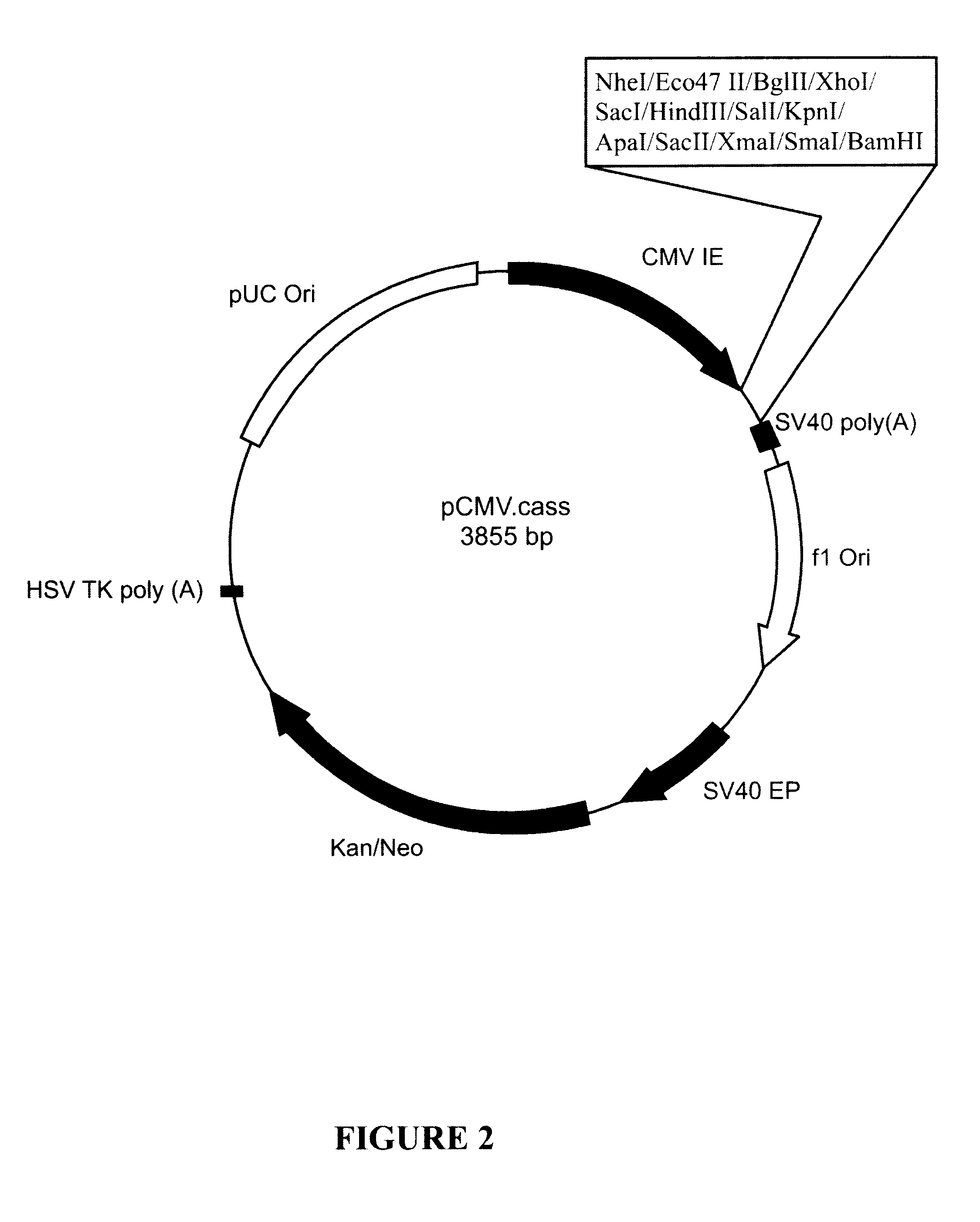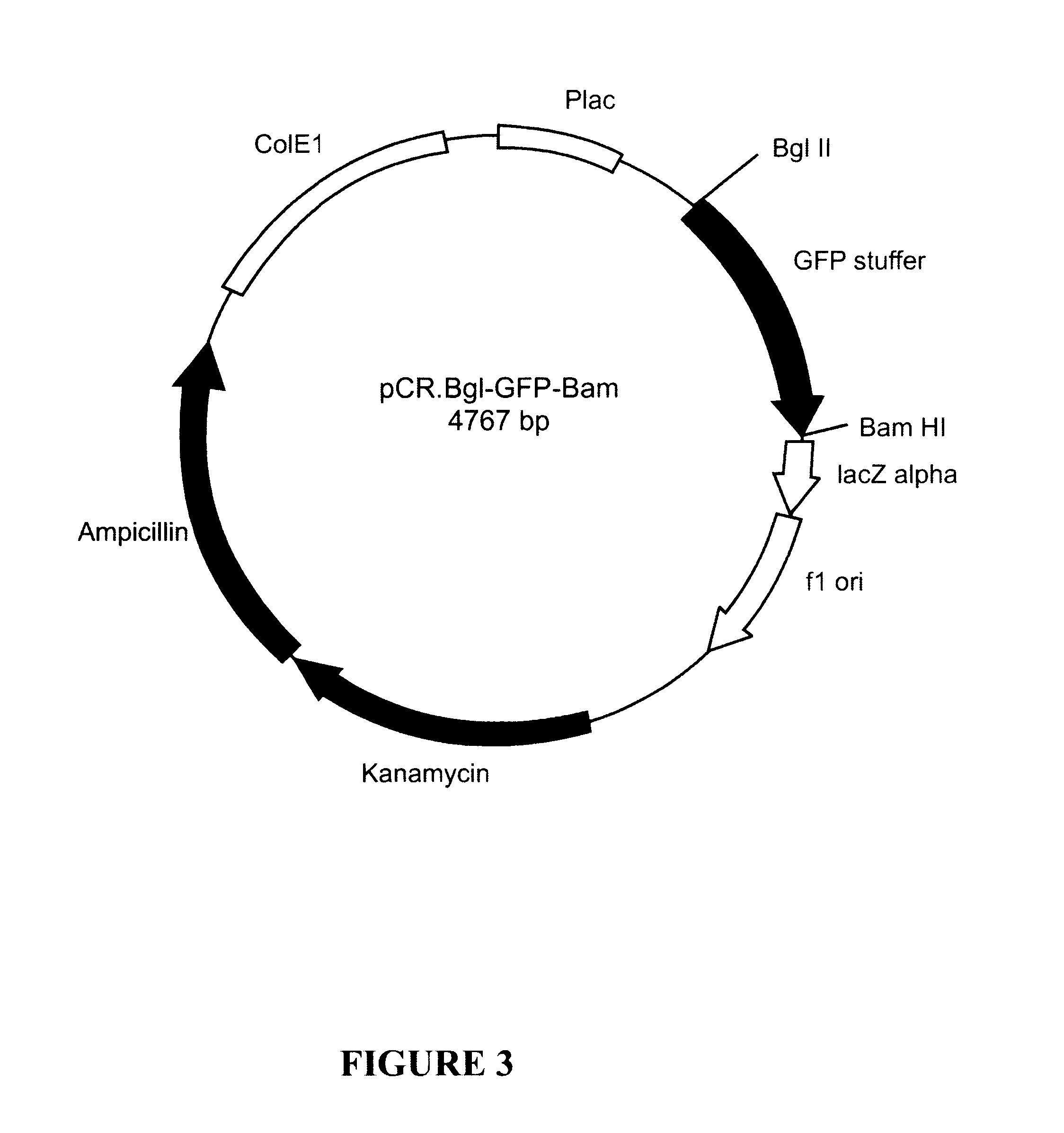Genetic constructs for delaying or repressing the expression of a target gene
a technology of target gene and gene, which is applied in the field of gene constructs for delaying or repressing the expression of a target gene, can solve the problems of repression, delay or reduction of eukaryotic gene expression, and less progress in actual manipulation of gene expression to produce novel traits
- Summary
- Abstract
- Description
- Claims
- Application Information
AI Technical Summary
Problems solved by technology
Method used
Image
Examples
example 2
BEV Polymerase-containing Genes
Plasmid pCR.BEV.1
The BEV RNA-dependent RNA polymerase coding region was amplified as a 1,385 bp DNA fragment from a full-length cDNA clone encoding same, using the primers designated BEV-1 (SEQ ID NO:1) and BEV-2 (SEQ ID NO:2), under standard amplification conditions. The amplified DNA contained a 5'-Bgl II restriction enzyme site, derived from the BEV-1 primer sequence and a 3'BamHI restriction enzyme site, derived from the BEV-2 primer sequence. Additionally, as the BEV-1 primer sequence contains a translation start signal 5'-ATG-3' engineered at positions 15-17 of SEQ ID NO:1, the amplified BEV polymerase structural gene comprises the start site in-frame with BEV polymerase-encoding nucleotide sequences, Thus, the amplified BEV polymerase structural gene comprises the ATG start codon immediately upstream (i.e. juxtaposed) to the BEV polymerase-encoding sequence. There is no translation stop codon in the amplified DNA.
The amplified BEV polymerase str...
example 3
Synthetic Genes Comprising a BEV Polymerase Structural Gene Operably Connected to the CMV-IE Promoter Sequence
Plasmid pEGFP.BEV.1
Plasmid pEGFP.BEV.1 (FIG. 9) is capable of expressing the BEV polymerase structural gene as a GFP fusion polypeptide under the control of the CMV-IE promoter sequence. To produce plasmid pEGFP.BEV.1, the BEV polymerase sequence from pCR.BEV.1 (FIG. 6) was cloned as a BglII-to-BamHI fragment into BglII / BamHI-digested pEGFP-N1 MCS (FIG. 1).
Plasmid pCMV.BEV.2
Plasmid pCMV.BEV.2 (FIG. 10) is capable of expressing the entire BEV polymerase open reading frame under the control of CMV-IE promoter sequence. To produce pCMV.BEV.2, the BEV polymerase sequence from pCR.BEV.2 (FIG. 7) was sub-cloned in the sense orientation as a BglII-to-BamHI fragment into BglII / BamHI-digested pCMV.cass (FIG. 2).
Plasmid pCMV.VEB
Plasmid pCMV.VEB (FIG. 11) expresses an antisense BEV polymerase mRNA under the control of the CMV-IE promoter sequence. To produce plasmid pCMV.VEB, the BEV p...
example 4
Synthetic Genes Comprising BEV Polymerase Structural Genes Operably Connected to Multiple Promoter Sequences
Plasmid pCMV.BEV.SV40L-O
Plasmid pCMV.BEV.SV40L-O (FIG. 16) comprises a translatable BEV polymerase structural gene derived from plasmid pCR.BEV.2 (FIG. 7) inserted in the sense orientation between the CMV-IE promoter and the SV40 late promoter sequences of plasmid pCMV.SV40L.cass (FIG. 5). To produce plasmid pCMV.BEV.SV40L-O, the BEV polymerase structural gene was sub-cloned as a BglII-to-BamHI fragment into BglII-digested pCMV.SV40L.cass DNA.
Plasmid pCMV.O.SV40L.BEV
Plasmid pCMV.O.SV40L.BEV (FIG. 17) comprises a translatable BEV polymerase structural gene derived from plasmid pCR.BEV.2 (FIG. 7) cloned downstream of tandem CMV-IE promoter and SV40 late promoter sequences present in plasmid pCMV.SV40L.cass (FIG. 5). To produce plasmid pCMV.O.SV40L.BEV, the BEV polymerase structural gene was sub-cloned in the sense orientation as a BglII-to-BamHI fragment into BamHI-digested pCMV...
PUM
| Property | Measurement | Unit |
|---|---|---|
| hydrophobicity | aaaaa | aaaaa |
| length | aaaaa | aaaaa |
| distance | aaaaa | aaaaa |
Abstract
Description
Claims
Application Information
 Login to View More
Login to View More - R&D
- Intellectual Property
- Life Sciences
- Materials
- Tech Scout
- Unparalleled Data Quality
- Higher Quality Content
- 60% Fewer Hallucinations
Browse by: Latest US Patents, China's latest patents, Technical Efficacy Thesaurus, Application Domain, Technology Topic, Popular Technical Reports.
© 2025 PatSnap. All rights reserved.Legal|Privacy policy|Modern Slavery Act Transparency Statement|Sitemap|About US| Contact US: help@patsnap.com



